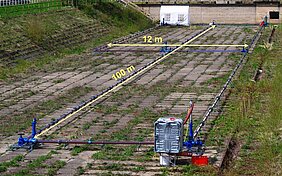To date there were no concrete recommendations for industry as to which flushing process should be used for which issue. As part of the research project, the flushing processes used in practice were investigated in detail and a matrix developed to select the ideal flushing process.
Flushing the drinking water network with the aim of expelling deposits is a key step in securing the quality of water required for water distribution. As flushing is a complex measure, this should be performed as efficiently and selectively as possible. In the DVGW standards there are currently no concrete recommendations as to which flushing method is ideally suited to which issue. To close this gap, the topic “flushing method for drinking water lines” was extensively addressed as part of three DVGW research projects.
In sub-project I, the theoretical bases of the flushing methods used in practice and experiences of water supply companies when using various flushing methods were studied.
In sub-project II, the water flushing with mains pressure, suction flushing and air-water flushing were investigated in detail on model net works of different dimensions.
In sub-project III, the flushing methods in a real drinking water network were investigated in terms of sustainability, based on the flushing intervals to avoid brown water caused by readily mobile deposits.
The investigations showed that a flushing plan with clear water should be carried out to systematically expel deposits from drinking water networks. Flushing speeds of 0.5 m/s should be reached to extensively remove typical, readily mobile deposits.
The removal of sand and manganese particles requires flow speeds of > 1 m/s. Adherent coatings of iron or manganese compounds are only partially removed by flushing with water at speeds of up to 2 m/s. Air-water flushing gives greater cleaning performance for adherent coatings than the water flushing method.
The used flushing method has no effect on the sustainability of the measure for the typical, readily mobile deposits as the system conditions in the distribution network determine the speed of deposit formation.
Publications:
Korth, A.; Donath, O.; Wricke, B.: Spülverfahren und Spülstrategien für Trinkwasserverteilungssysteme – Einsatzmöglichkeiten und Einsatzgrenzen [Flushing methods and strategies for drinking water distribution systems – application options and limits], DVGW energie | wasser-praxis 6/2011, 24-28 (2011)
Korth, A., Donath, O.: Spülverfahren für Trinkwasserleitungen problemspezifisch auswählen [Selecting flushing methods for drinking water lines according to the specific problem]. DVGW energie | wasser-praxis 1/2015, 36-41 (2015)
Korth, A.; Donath, O.: Spülverfahren für Trinkwasser [Flushing methods for drinking water]. Aqua & Gas 11/2015, ISSN 2235-5197, 42-47 (2015)
Donath, O.; Korth, A.: Bewertung von Spülverfahren für Trinkwasserleitungen [Assessment of flushing methods for drinking water lines]. Veröffentlichungen aus dem Technologiezentrum Wasser [Publications from TZW] 69, ISSN 1434-5765 (2015)

![[Translate to English:] Prüfstelle-Produktprüfung_Teststand Test centre and product testing](/fileadmin/_processed_/0/9/csm_TZW-Karlsruhe_Pruefung_Geraete-Teststand_377188946c.jpg)

























